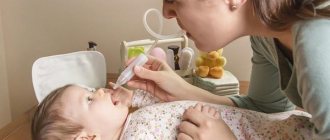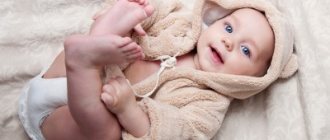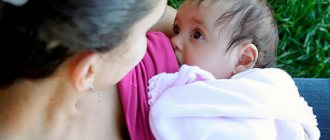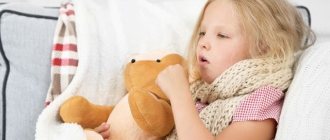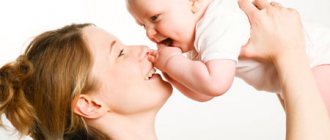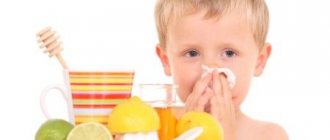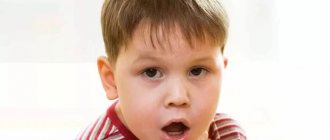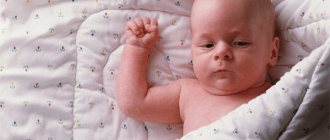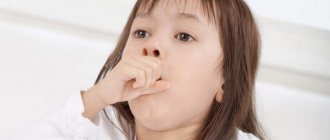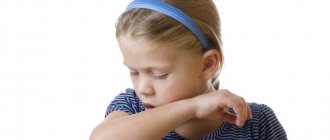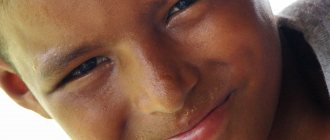A runny nose and cough at any age indicate the presence of an allergy, cold or ARVI. Adults, knowing this fact, either independently buy a familiar remedy that has proven itself more than once, or ignore the symptoms, because, as you know, a common cold goes away in a week, whether it is treated or not. However, a runny nose and cough in a baby can seriously frighten young parents. And this is quite fair, because the child’s body has not yet acquired reliable immunity. You will learn from this article how to act if your baby shows signs of a cold.
Causes of occurrence: what is considered normal?
Every young mother definitely needs to know that there is a so-called physiological runny nose and cough in infants. Such a runny nose occurs in the first days of a baby’s life and is considered an absolutely normal manifestation of the newborn’s body adapting to a new environment. The glands located in the nose do not yet “know how” to secrete the amount of mucus necessary to maintain a normal level of hydration. As a result, more of it is formed than necessary, and symptoms of a pseudo-cold appear, which occurs without fever. After a few days, this runny nose gradually disappears without any treatment.
Babies start teething at the age of six to seven months. This time cannot be called easy for either mother or baby. After all, teething may be accompanied by an increase in temperature, increased salivation (salivation), as well as the appearance of copious discharge from the nose. This phenomenon is considered a normal reaction to teething: as a rule, after a few days the baby’s condition returns to normal on its own.
Another cause of a runny nose and cough in an infant can be excessive regurgitation.
The reflex cough that accompanies a child’s physiological runny nose is explained by the fact that mucus flowing down the back wall of the nasopharynx causes irritation.
Night cough in a child
Some children cough mainly during sleep, this can be caused by many reasons:
- The cough is wet and the child has not coughed enough during the day and before bed, the lying position provokes greater contact of accumulated mucus from the bronchial mucosa. In this case, it is necessary to ensure that you cough up sputum before going to bed.
- Rhinitis in a child, in which mucus draining from the nose irritates the back of the throat, causing a cough.
- The use of heating devices, due to which the air in the room becomes dry and dries the surface of the mucous membranes during breathing.
- A night cough can occur with whooping cough, bronchial asthma, allergies to pillow fluff and other substances in a sleeping child’s room.
Often during a respiratory illness in children, especially in the first year of life, a kind of rough, barking cough occurs.
When crying, the child's voice becomes rougher, this is explained by the fact that as a result of swelling of the mucous membrane of the larynx, the lumen of the respiratory tract narrows, the child's breathing becomes difficult and loud.
This condition is very dangerous for the baby, and parents should immediately call a doctor, as complete closure of the upper respiratory tract and asphyxia may occur.
Pathological causes of cough and runny nose
In infants, a runny nose usually appears due to pathogens getting on the mucous membranes. As a rule, the infection is accompanied not only by a cough and runny nose, but also by elevated body temperature, lethargy, moodiness, decreased appetite, sleep disturbances, etc.
A severe cough may indicate that the disease is affecting the respiratory tract, such as the trachea or bronchi. In this case, the cough can be either dry (non-productive) or wet (with sputum discharge). Similar processes in a newborn often occur due to the fact that mucus from the nose, which arose in the first stages of the development of the disease, was not removed using special devices. After all, it is known that an infant is not able to blow his nose on his own, as a result of which a cold causes him much more suffering than an adult. In order for the baby to be able to breathe and sleep peacefully, he definitely needs to put special drops into his nose, which constrict the blood vessels, relieve swelling and reduce the secretion of mucus.
In an infant, a cough and runny nose can be caused by asthma, an allergic reaction to dust, lint, synthetics, wool or animal feed, new foods, or detergents. A cough also occurs after a foreign body gets into the throat, which is extremely dangerous for the child’s life. The foreign body must be urgently removed from the respiratory tract, and an ambulance must be called.
How to relieve a child who is coughing?
It depends on what kind of cough the child has.
If you have a dry cough, you should give your child warm drinks more often and provide sufficient air humidity, which will protect the mucous membrane from drying out.
Drinking small sips of a warm beverage frequently will reduce irritation of the upper respiratory tract.
It’s hard to think of anything better for infants than warm drinks and breast milk.
If your baby has a normal temperature, you can place a warm heating pad on his chest closer to his neck, wrapping it in a towel.
Heat expands the bronchi, and the cough will stop for a while.
Perhaps your baby will feel better if you just hold him close and warm him with your own warmth.
If a child’s cough bothers him when he is put into bed, this may be a consequence of mucus from the nose entering the nasopharynx; such a cough does not bother the baby much and he continues to sleep.
To eliminate the problem, it is enough to place the child on his side or tummy, then the mucus will flow out without irritating the respiratory tract.
You should not increase the temperature in the room where the child is located using heaters, because they quickly dry out the air.
If parents think that the baby is cold, it is better to dress him warmer.
With a wet cough, it is very important that the child is able to remove the mucus that has collected in the respiratory tract.
The smaller the child, the more difficult it is to remove phlegm and the more dangerous the accumulation of mucus in the respiratory tract.
In this case, the child needs help. It is important for parents to remember that expectorants are used in children under 1 year of age only with the permission of a doctor.
You can help your child clear his throat by gently pressing his tongue as far as possible with a spoon.
It is better if a doctor teaches this technique so as not to provoke vomiting.
Mucus is removed more easily if the child is placed on your lap so that the head is slightly lower than the body.
At the same time, very lightly pat the baby’s back towards the neck, alternating with stroking.
Antitussives should not be given to infants under 1 year of age; they are dangerous because they lead to stagnation of mucus in the respiratory tract and the development of complications.
How does a runny nose occur in a baby?
Viral or bacterial rhinitis in infants occurs in three stages:
- the child sneezes, the nasal mucosa swells. Nose is stuffed. Nasal discharge is scanty and transparent;
- the child’s nose is so blocked that he can only breathe through his mouth;
- Thick yellow or greenish discharge comes from the nose. This indicates a speedy recovery.
At each stage of the disease, a cough is observed. At first it is quite weak, but as rhinitis develops it intensifies
Under no circumstances should such symptoms observed with rhinitis be ignored. If the disease is started, it will develop gradually, affecting deeper and deeper areas of the respiratory system. As a result, the child may develop a dangerous condition such as pneumonia.
Cough and runny nose are especially dangerous for children who have problems with the immune system or were born premature. Parents should be especially attentive to their condition.
Is your baby coughing and sneezing, but no temperature?
Is your baby coughing and sneezing, but no temperature?
Cough, like a runny nose, is a frequent companion to most respiratory diseases.
Its task is to rid the body of foreign substances: viruses, bacteria, small particles of dust, various allergic particles.
In everyday life, a small amount of them necessarily gets into the child’s respiratory tract, but with the help of mucus, protective antibodies and the structural features of the bronchial mucosa, the body quietly gets rid of them.
When a child gets sick, there is more mucus, and coughing helps remove it and reopen the airways.
But coughing does not always give relief; it often disturbs sleep, worsens the child’s well-being and worries parents.
In addition, it can be a sign of diseases more serious than acute respiratory infections, and the use of various, especially combined antitussive drugs can worsen the child’s condition.
Therefore, parents should know that a baby who is coughing must be examined by a doctor.
A cough can be a manifestation of inflammation of the mucous membrane of any part of the respiratory tract, namely a symptom of one of numerous diseases.
Diseases accompanied by cough
- Laryngitis (inflammation of the larynx), in this case the cough is rough, barking, and may be accompanied by noisy breathing.
- Tracheitis is a rough cough that can be painful. This cough is also possible with further acute respiratory infections.
- Bronchitis is a cough that is initially dry and frequent, then becomes less frequent and wet. With obstructive bronchitis, wheezing is noted.
- Pneumonia - the nature of the cough can be similar to bronchitis, but is determined by the severity of the baby’s condition. Shortness of breath is possible; in case of complications with pleurisy, pain may be felt in the intercostal spaces during coughing.
- Children's infections.
With measles, along with the symptoms characteristic of this infection, an obsessive, painful cough is observed. With whooping cough and parawhooping cough, the cough is paroxysmal with characteristic pauses in breathing. - Allergic diseases. Along with cough, other manifestations of allergies are observed - various rashes, itching, lacrimation.
- Tuberculosis of the respiratory system. This is also worth remembering, but as a rule, the disease is identified in the early stages.
- Bronchial asthma.
The nature of the cough can be different - dry, paroxysmal, wet and deep, and may be accompanied by wheezing. Often, an obsessive cough may be the first or only manifestation of this disease. - Pleurisy.
This is a complication of pneumonia, in which inflammation spreads to the membrane surrounding the lung tissue, the pleura. In this case, the cough is accompanied by pain in the chest, possible pain in the tummy, and the child’s condition is serious. - Coughing in infants can also be observed with rhinitis: mucus from the nasal cavity flows down the back wall of the throat, and due to its irritation, the baby may cough periodically.
In this case, the cough will be infrequent and short-lived. A superficial cough can be observed with adenoid growths, with possible difficulty breathing and nasal discharge. If there is insufficient air humidity in the room, respiratory discomfort may occur, especially in winter when using different heaters. - A cough can occur as a result of milk entering the respiratory tract during breastfeeding (especially in children who often regurgitate). The child must be monitored, as frequent repetition of such cases can lead to the development of pneumonia.
It depends on what kind of cough the child has
If you have a dry cough, you should give your child warm drinks more often and provide sufficient air humidity, which will protect the mucous membrane from drying out.
Drinking small sips of a warm beverage frequently will reduce irritation of the upper respiratory tract.
It’s hard to think of anything better for infants than warm drinks and breast milk.
If your baby has a normal temperature, you can place a warm heating pad on his chest closer to his neck, wrapping it in a towel.
Heat expands the bronchi, and the cough will stop for a while.
Perhaps your baby will feel better if you just hold him close and warm him with your own warmth.
If a child’s cough bothers him when he is put into bed, this may be a consequence of mucus from the nose entering the nasopharynx; such a cough does not bother the baby much and he continues to sleep.
To eliminate the problem, it is enough to place the child on his side or tummy, then the mucus will flow out without irritating the respiratory tract.
You should not increase the temperature in the room where the child is located using heaters, because they quickly dry out the air.
If parents think that the baby is cold, it is better to dress him warmer.
With a wet cough, it is very important that the child is able to remove the mucus that has collected in the respiratory tract.
The smaller the child, the more difficult it is to remove phlegm and the more dangerous the accumulation of mucus in the respiratory tract.
In this case, the child needs help. It is important for parents to remember that expectorants are used in children under 1 year of age only with the permission of a doctor.
You can help your child clear his throat by gently pressing his tongue as far as possible with a spoon.
It is better if a doctor teaches this technique so as not to provoke vomiting.
Mucus is removed more easily if the child is placed on your lap so that the head is slightly lower than the body.
At the same time, very lightly pat the baby’s back towards the neck, alternating with stroking.
Antitussives should not be given to infants under 1 year of age; they are dangerous because they lead to stagnation of mucus in the respiratory tract and the development of complications.
Some children cough mainly during sleep, this can be caused by many reasons:
- The cough is wet and the child has not coughed enough during the day and before bed, the lying position provokes greater contact of accumulated mucus from the bronchial mucosa. In this case, it is necessary to ensure that you cough up sputum before going to bed.
- Rhinitis in a child, in which mucus draining from the nose irritates the back of the throat, causing a cough.
- The use of heating devices, due to which the air in the room becomes dry and dries the surface of the mucous membranes during breathing.
- A night cough can occur with whooping cough, bronchial asthma, allergies to pillow fluff and other substances in a sleeping child’s room.
Often during a respiratory illness in children, especially in the first year of life, a kind of rough, barking cough occurs.
When crying, the child's voice becomes rougher, this is explained by the fact that as a result of swelling of the mucous membrane of the larynx, the lumen of the respiratory tract narrows, the child's breathing becomes difficult and loud.
This condition is very dangerous for the baby, and parents should immediately call a doctor, as complete closure of the upper respiratory tract and asphyxia may occur.
Before the doctor arrives, you must
First of all, you need to provide the child with cool and moist air.
You can go outside, if the weather permits, or open the windows in the room, hang wet diapers everywhere, and use a humidifier.
If this is not possible, pour water into the bathtub, pick up the child in your arms and stay with him in the bathroom for 10-20 minutes.
If the child does not resist, give him something to drink and do not give him any medicines to treat a cold; they can provoke the baby’s agitation and worsen the condition.
Acute bronchitis in infants differs from bronchitis in older children in that in infants the bronchial mucosa is still very delicate and more mucus collects, and the cough reflex is even lower.
Mucus, accumulating in the bronchi, makes it difficult for the baby to breathe, and parents hear wheezing, which decreases or disappears during coughing.
Since the immunity of infants is still quite weak, complications may develop, in particular pneumonia.
Therefore, antibiotics are used in the treatment of children in the first months of life, and the doctor recommends hospitalization in a children's hospital.
Regardless of whether the child is prescribed antibiotics or not, whether he is being treated at home or in the hospital, the baby needs to be helped to cough up accumulated mucus.
If it works, you can lightly press the spoon on the tongue and the baby will cough; if not, the natural method will help.
You shouldn’t immediately calm the baby down when he’s crying; literally a minute of crying fills his lungs with oxygen, which will help the baby cough up phlegm and clear the airways.
Loud laughter has the same effect, the effect is enhanced by positive emotions and helps the baby recover faster.
Parents should know that repeated bronchitis is dangerous not only in itself, but also because it can lead to the development of bronchial asthma.
For pneumonia in infants, in addition to symptoms such as cough and fever, others are added:
- weakness
- poor appetite or breast refusal
- baby sweats often
- gets tired quickly
- shortness of breath is observed
- drowsiness
- Blueness may appear around the mouth and nose.
If such symptoms appear, you should immediately call a doctor to begin timely treatment.
You should think about the possibility of developing bronchial asthma in a child if the following symptoms are observed:
- wheezing when exhaling
- frequent bronchitis
- a cough that gets worse at night and wakes the child up
- paroxysmal cough that persists for a long time after suffering from bronchitis, pneumonia or acute respiratory infections
If the diagnosis is confirmed by a doctor, treatment should be started as early as possible; often, the administration of hormones through inhalation at the beginning of the disease under the constant supervision of a doctor allows one to overcome asthma.
In addition, there are many other ways to cure this disease.
It is very important to find exactly the method that will help the child recover as quickly as possible, before the disease starts.
Among them the following are recommended:
- spa treatment
- speleotherapy in salt caves
- phytotherapy
- homeopathy
- physical therapy and massage
It should be remembered that in the first months of life, when immunity has not yet been formed, the baby is not sufficiently protected from the effects of viruses and bacteria.
But children who receive breast milk have protective antibodies to many infections, and such babies get sick less often and recover faster than bottle-fed children.
The parents’ task is to ensure that there are as few microbes as possible in the child’s environment until the baby’s immune system gets stronger and is fully formed.
This is fully achieved by good care of the baby, long-term breastfeeding, limiting his contact with sick children and adults, as well as preventive vaccinations.
Gradually, the baby’s own immune system will learn to produce antibodies and resist pathogens of infectious diseases, but its formation takes place in stages and this process is very individual.
The final formation of the immune system ends at approximately 3 years of age.
Source: https://pneumonia03.ru/lor/kashel/grudnichok
What to do if your baby gets sick?
If a newborn baby coughs and his nose is clogged, you should consult a doctor who will make a diagnosis and prescribe treatment. Treating an infant with the same means that are used for adults, for example, vasoconstrictor drops with a high concentration of the active substance, is strictly prohibited!
Such drops can cause a burn to the delicate mucous membrane of the child’s nose, and some cough syrups simply suppress the natural reflex, as a result of which the baby cannot get rid of the mucus accumulated in the respiratory passages.
Infants can react to any, even the “safest” drugs, with allergic reactions and digestive disorders, so treatment should be under the supervision of a pediatrician
You can help your child at home in the following ways:
- buy a humidifier. If this is not possible, you can simply place wet towels on the central heating radiators. It is especially important to humidify the air during the cold season;
- Special gymnastics and massage help to achieve a good result with a wet cough. For example, an effective method of drainage massage is to lightly pat the baby on the back with the edge of your palm. Massage can be done only when the child is without fever;
- the child should be carried vertically in his arms: this will relieve cold symptoms;
- for a dry cough, rubbing the child’s back and chest with special ointments with a warming effect is recommended. You need to choose ointments carefully. The product should not contain dyes and have a strong odor, otherwise the baby may develop bronchospasm or a severe allergic reaction;
- during illness, the child should drink at least 200 ml of water per day. To sanitize the neck, you can give weak chamomile tea. Brew at the rate of 1 heaping teaspoon of dry raw material per 0.5 liters of water, boil for 2-3 minutes, let steep until completely cool, strain through a double layer of gauze. Give the child 5-6 teaspoons of decoction per day to drink, adding the medicinal infusion to lukewarm boiled water. This must be done with caution: some children are allergic to medicinal chamomile;
- You should not put mother's milk in your baby's nose. Many “experienced” women offer this method of treating a runny nose, claiming that mother’s milk helps with any adversity. However, this is not so: sweet milk is an excellent breeding ground for the development of pathogenic bacteria, as a result of which the amount of mucus released only increases;
- A baby's runny nose and cough cause him a lot of suffering. To help the baby breathe, you need to regularly carefully suck out the mucus from the nose using a special aspirator, which is a small bulb with a soft rubber tip;
- Walk in the yard only if the baby feels well, and the temperature outside is above zero and there is no wind. You shouldn’t overheat your baby either, so it’s better to avoid excessive wrapping.
Traditional methods of treating cough in an infant
Some parents themselves do not go to the doctor and, after the birth of the baby, if there are any symptoms or a deterioration in his health, they try to cope themselves and treat the cough at home. This is one of the huge mistakes of parents, because in this way they only make the situation worse. Nature provides a large number of methods of combating diseases, but together with goodness it can cause harm to the body. It is strictly not recommended to use folk remedies without a doctor. After consultation with a pediatrician, you can perform subsequent operations; when the baby coughs, sneezes, but there is no temperature, you need to clear the airways and eliminate the cough. Drainage massage is carried out even for children aged six months. The massage is performed as follows: the baby is placed on the knee so that the stomach is directed down and the head is located below the horizontal. Make knocking movements with your fingers from the lower back to the occipital region.
Cough compress for babies
The child's chest, back, and feet are rubbed with badger fat. The procedure is performed before bedtime to wrap the child warmly. Any ointments are contraindicated at this age.
Inhalations for an infant
When your baby is sick with respiratory diseases, consider buying an inhaler or nebulizer. With the help of inhalations, the respiratory system is treated for various diseases. You can use a regular sodium chloride solution (used in the clinic) and the result will be noticeable immediately.
Massage for a runny nose
To alleviate the baby’s condition with a runny nose and colds, the mother should learn simple massage techniques. It is important to remember that such a massage can only be done if the baby feels satisfactory and does not have a fever.
So, the massage is done as follows:
- start massaging the wings of the nose and the points that are located near them. Under the nose you need to massage with light movements, lightly touching the baby’s skin;
- All points need to be massaged for 2-3 minutes, alternately making 10 circles to the right and left.
You can do this massage up to seven times a day. It is great for getting rid of runny nose. In order not to harm the child, you should not actively influence the baby’s eyebrows and temples.
The massage should be done while telling the child rhymes or singing his favorite songs.
The baby is coughing and sneezing, no fever
The state of health when a baby coughs and sneezes gives rise to concern among parents, because in the majority of cases there is no temperature and it is much more difficult to determine the root cause.
Before starting therapy for your baby, you need to make sure that the symptoms that arise are not related to the disease, because a newborn baby sneezes and coughs for various reasons and you need to initially find out the cause, and only then decide what to do.
Causes of cough in infants
The baby coughs and sneezes not only for physiological reasons, but due to a certain illness. The cough reflex is a method of eliminating obstacles that interfere with normal air circulation. There are times when a baby coughs and sneezes, but there are no signs of illness. Why does a newborn cough and sneeze?
The cough reflex has the following causes or may be a factor in a specific disease:
- Infection in the respiratory system. It has been established that the baby’s body is more often exposed to the influence of microbes, therefore, when bacteria enter the newborn, the newborn sneezes and coughs. For this reason, experts recommend that father and mother in the first weeks of the baby’s life beware of contact with strangers so as not to infect him with infection. When such signs as sneezing and coughing are caused by a cold, increased body temperature, rhinitis, and lethargy of the body can be observed.
- Huge amount of sputum. When an infant coughs and sneezes, this indicates an accumulation of mucus, which irritates the nasopharynx and settles in the respiratory tract, that is, a condition in which the infant coughs.
- Dry air in the room is one of the causes of coughing and sneezing. When airing, the air in the room becomes fresher and the environment in the room changes.
- A possible cause of cough is an allergy. Children are more likely to experience allergic reactions than adults. This reaction occurs due to dust formation, animals, their fur, plants, cigarette smoke, and chemicals. So, when the father and mother have discovered that the baby is coughing and sneezing, it is necessary to eliminate all of the listed factors.
The conditions that trigger coughing and sneezing in an infant will disappear if parents follow these recommendations every day. However, as pediatric doctors say, today children are born with pneumonia, a sign of which is a continuous wet cough.
When the parents saw that at the age of 1 month the baby began to fidget frequently, cry for no reason, refuse to eat, and this continues for the first few days, then it is necessary to exclude the presence of a cold. When an infectious disease occurs in children, there is a high fever, sore throat and other symptoms.
If coughing does not stop for more than 3 days, you should call a doctor. When a baby sneezes, this may indicate a disease, for example:
Acute respiratory diseases, when a child coughs and sneezes, as the infection spreads to the respiratory system.
Bronchial asthma does not appear by itself, but as a result of prolonged bronchitis and untreated allergies.
Croup often occurs in babies between 3 months and three years of age; the baby coughs and sneezes, but there is no fever.
With whooping cough, a spasmodic cough can be observed until vomiting occurs. The disease is especially dangerous for children under one year of age, as it causes convulsions, after which the baby may stop breathing.
Diseases of the pharynx, ear, nose and larynx. A chest cough can indicate inflammation if the diagnosis is bronchitis or pneumonia.
If an infant is coughing and sneezing, but there is no fever, other symptoms must be ruled out. In the first days, the disease does not show any severe symptoms, so a visit to the doctor is required.
How to treat a cough in an infant
The best decision for parents when treating babies under 1 year of age is to consult a doctor. Especially when the conversation is about a coughing child or children 2 months old. It is strictly forbidden to choose medications yourself, because this can cause even greater harm to the child.
In any case, for a quick recovery, the child needs to drink a lot of liquid (milk in this case is not a liquid, but the baby’s food). Toxic substances are removed from the tiny patient’s body along with the fluid. Give purified water, herbal decoctions, natural juices, compotes at room temperature.
During sneezing, blockage of the nasal cavity may occur. Therefore, it is necessary to clean the nasal passages of the baby using a solution with salt. The drug is sold at the pharmacy kiosk, and you can also make it yourself (a pinch of salt per 250 ml of water).
Such solutions should be used when a 2-month-old child coughs and sneezes for more than 3 days. At the pharmacy you can buy a substance for cleansing the nasopharynx Aquamaris, No-salt.
Methods for treating dry cough in an infant
There are times when an infant coughs, sneezes, but there is no temperature, this means the presence of an infection. Cough occurs in the morning and evening, which may indicate the likelihood of inflammation of the larynx and ligaments or a symptom of whooping cough. When there is no pneumonia, treatment of dry cough should be aimed at removing mucus.
For a dry cough, the infant is given milk with honey, and inhalation is carried out with a two percent soda substance.
Methods for treating wet cough in an infant
Sputum that is formed during a wet cough must be removed from the respiratory tract. When a newborn coughs, sneezes, or has no fever, expectoration agents are used. Inhalations are also useful, and infants are prescribed topical syrups, for example, Pectusin, Doctor Mom.
The drugs must be used exclusively as prescribed by the doctor, since if there is excess sputum, the child cannot independently cope with the discharge of mucus.
It is also prohibited to use pharmaceutical herbs independently to treat infants, but only under the guidance of a doctor, so as not to cause allergies.
If a wet cough occurs, it is recommended to massage it to facilitate the removal of sputum. All possible operations when treating an infant should be discussed with the pediatrician in advance.
Adhering to an infant's cough regimen
When a baby sneezes or coughs, the doctor is obliged to conduct a full examination, and only after determining the diagnosis, prescribe treatment. When parents discover that the baby is coughing, the mother at home is obliged to do the following:
- Constantly ventilate the child's room. The temperature does not have to exceed 22 degrees. Certain diseases, for example, croup and whooping cough, are treated by ventilating the room.
- When the disease occurs without fever, you should take walks in the fresh air more often.
- When a baby coughs or sneezes without developing a fever, you need to start restoring breathing. To begin with, a special device, a bulb, is useful for clearing the mucus of the nasal cavity.
- Moisten the room with damp towels and place containers with water.
- Adhere to the drinking regime so that the baby’s body does not become dehydrated.
- When coughing with sputum that is difficult to clear, you can perform a drainage massage.
Drug therapy Medicines
When visiting a doctor, parents are required to inform the medical professional about the baby’s behavior and suspicious symptoms. After all, the diagnosis depends on this information.
When the available methods do not work, you need to purchase drugs to remove mucus. There are herbal preparations in pharmacies, for example, Mucaltin, Bromhexine.
When the cough is allergic in nature, the doctor prescribes antihistamines, for example, Suprastin, Tavegil, Fenistil.
For a viral infection, local remedies will help. When a child is 3 months old, Grippferon, Interferon is prescribed.
At the age of 3 months, babies can cough for various reasons, so when the baby coughs or sneezes, you need to be examined by a doctor. After all, the cause may also be the entry of an object into the respiratory tract.
During the treatment period, it is necessary to support the baby’s immunity with vitamins.
When coughing with fever, antipyretic drugs are prescribed, for example, Diclofenac, Nurofen.
Traditional methods of treating cough in an infant
Some parents themselves do not go to the doctor and, after the birth of the baby, if there are any symptoms or a deterioration in his health, they try to cope themselves and treat the cough at home. This is one of the huge mistakes of parents, because in this way they only make the situation worse.
Nature provides a large number of methods of combating diseases, but together with goodness it can cause harm to the body. It is strictly not recommended to use folk remedies without a doctor.
After consultation with a pediatrician, you can perform subsequent operations; when the baby coughs, sneezes, but there is no temperature, you need to clear the airways and eliminate the cough. Drainage massage is carried out even for children aged six months.
The massage is performed as follows: the baby is placed on the knee so that the stomach is directed down and the head is located below the horizontal. Make knocking movements with your fingers from the lower back to the occipital region.
Cough compress for babies
The child's chest, back, and feet are rubbed with badger fat. The procedure is performed before bedtime to wrap the child warmly. Any ointments are contraindicated at this age.
Inhalations for an infant
When your baby is sick with respiratory diseases, consider buying an inhaler or nebulizer. With the help of inhalations, the respiratory system is treated for various diseases. You can use a regular sodium chloride solution (used in the clinic) and the result will be noticeable immediately.
Conclusion
Coughing and sneezing are normal physiological processes that are typical for a child of any age and are not always associated with respiratory diseases.
In medical practice, it is not uncommon for children to be taken to intensive care due to the fault of parents, their increased initiative in terms of independent treatment, and sometimes even die.
Therefore, if any suspicious symptom or change in the child’s behavior appears, it is better to immediately contact the clinic for examination.
Source: https://kashlya-net.ru/kashel/grudnichok-kashlyaet-i-chihaet
Prevention of runny nose and cough
Parents need to remember that any disease is much easier to prevent than to treat. Therefore, you should follow simple preventive measures that will help reduce the likelihood of an infant developing acute respiratory diseases, as well as cough and runny nose caused by other reasons:
- Children's immunity is not yet fully formed. Therefore, it is important that the child does not have contact with people sick with acute respiratory viral infections and acute respiratory infections. If one of the baby’s relatives has a runny nose and cough, you should limit their contact with the baby, and if this is not possible, then wear a mask at each contact;
- Try not to take your child to large crowds of people for up to six months: supermarkets, markets, public transport. Normal sneezing for an adult can result in meningitis for an infant. And this is not an exaggeration;
- It is important to ventilate the room in which the newborn sleeps, but in no case should the baby be allowed to remain in a draft;
- If you suspect allergic rhinitis, remove all possible allergens, for example, exclude a new food product from the diet of a nursing mother, remove all soft toys from the children's room, give the pet (even fish) to relatives or friends for a while (along with the toilet and food) so that make sure it is not an allergen. Also remove indoor plants;
- do not use fabric softeners with a strong smell and do not smoke around the child;
- At the first symptoms of a runny nose, mucus should be regularly removed from the baby’s nose. This will help avoid further development of the disease.
Important! A severe cough should cause you to see a doctor immediately! Remember this and do not try to treat your child using only traditional methods and advice from forums.
Cough and runny nose in an infant can be both physiologically normal phenomena and symptoms of a viral or bacterial infection. Contact your doctor in a timely manner and make sure that your baby does not come into contact with infected people during epidemics.
Baby coughs and sneezes without fever: what to do and why this happens
The first reaction of parents is alarm when their newborn coughs and sneezes.
However, both the cough and sneezing of an infant perform basic functions of the respiratory system: protection against harmful substances entering the body. That's why, in many cases, moms don't have to worry. The child is coughing
When coughing and sneezing are dangerous symptoms
Babies, especially those who are breastfed, rarely get sick in the first months of life. The protection they receive from breast milk usually prevents infections from entering their bodies.
However, sometimes infections are the reason that a newborn coughs and sneezes, there is no fever, because the baby is not yet strong enough, and his body’s own defenses do not actively fight against viruses and bacteria. Also, these symptoms may be the first manifestations of an allergic reaction.
When to be wary:
- A skin rash appears;
- Sputum is released when the child coughs;
- The baby has trouble falling asleep, may snore in his sleep, cries, and refuses to eat.
Restless baby
Important! When a baby sneezes, coughs, and at the same time has additional symptoms, you should consult a pediatrician.
Factors that cause infant cough
There are several factors that provoke a cough in an infant that is incomprehensible to parents.
Physiological
A newborn baby laughs in his sleep - reasons and what parents should do
Sneezing is a reflexive, or automatic, act that serves to clear the newborn's nose. Any lint or dust on clothing can trigger sneezing.
The cough reflex is a protective mechanism of the respiratory tract. When the baby coughs, they are unblocked and cleared so that air can freely penetrate into the bronchi.
Infectious
If your newborn coughs and occasionally sneezes as a result of respiratory infections or the flu, it is caused by nasal congestion. The baby is forced to breathe through his mouth, then the mucous membrane dries out and he begins to cough.
Important! The smaller the baby, the lower his ability to breathe through his mouth. Therefore, the mucus that clogs the nostrils during ARVI also causes coughing, sneezing, and restless behavior in the baby. In this case, it is imperative to rinse the child’s nose with saline solution, use Aqualor or other means.
Rinse the nose with saline solution
Non-infectious
A non-infectious cough is not associated with the presence of viruses and bacteria and can be either physiological or caused by allergic reactions or too dry air in the room.
Types of cough
A newborn sleeps little and eats little - reasons
There are two main types of cough:
- Productive - most common in children, as it serves to clean the airways. A cough of this kind allows you to expel both microorganisms entering through the respiratory tract and mucus secreted by the bronchi.
Important! Many pediatricians consider it inappropriate to treat a productive cough, although soothing home remedies can be used, for example, warming the bronchial area, etc.
- Irritating, or dry. In most cases it is caused by the environment. Only air is expelled from the lungs and bronchi. In many cases, it is explained by allergic problems or external irritants: tobacco smoke, dry air. A dry cough tires and irritates the baby. If necessary, the doctor prescribes treatment.
Other types:
- barking cough that occurs with inflammation of the larynx or trachea;
- cough with wheezing, indicating asthma or lower respiratory tract disease.
Causes of coughing and sneezing without fever
Vomiting in a child without fever
If the baby sneezes and coughs, there is no fever, this may be caused by the following reasons:
- Children still have narrow airways and produce a lot of mucus. This leads to constant sneezing in a one-month-old baby. Even 15-20 times a day is considered normal;
- Sometimes newborns cough while burping. In this way, the body prevents stomach contents from entering the bronchi;
- Cough when exposed to a foreign body. Occurs when the baby has no previous cold symptoms and suddenly starts coughing continuously.
- A baby may cough and sneeze without fever during teething. During this period, increased salivation occurs, and saliva may enter the respiratory tract;
- When a baby coughs and sneezes due to allergies, the temperature usually does not rise.
Important! Allergic symptoms should alert parents, in which case consultation with a doctor is necessary.
How to prevent and calm a cough
Even if a child coughs for natural reasons not related to respiratory or other diseases, in most cases this reflex can be stopped or weakened.
Methods that can calm a cough:
- Frequent ventilation;
- Preventing high indoor temperatures and keeping them stable throughout the day;
- Humidifying the air in the room where the child sleeps;
Air humidification
- Place a slightly higher pillow when your baby falls asleep. This helps partially clear the airways;
- Let the baby drink more. This is especially useful for productive coughs, as it helps to liquefy bronchial secretions and facilitate their removal;
- If there is mucus, you should rinse your nose with saline several times a day;
- Avoid exposure to tobacco smoke;
- In the case of an allergic cough, you need to find out what can provoke it and eliminate dangerous factors: indoor plants, pets, etc.;
- It is necessary to regularly wipe off dust and wash the floor, avoiding the use of household chemicals.
Important ! Herbal antitussive infusions are not recommended for infants, as their components can provoke allergic reactions.
A good way to speed up the discharge of sputum during a productive cough in infants over three months of age is drainage massage. It is done a few days after the cough starts. Approximate procedure:
- Warm or rub your palms so that they are warm, lubricate the baby's skin with baby cream;
- Place the baby on his tummy, the position should be slightly tilted down towards the head;
Performing drainage massage
- Rub the baby's back, gently pressing with your fingers. Direction – from the waist to the shoulders. Then turn the baby over and stroke your hands towards the neck in the central part of the chest. The skin should turn slightly red;
- Massage for 10 minutes twice a day. After the massage, wrap the child in a blanket and put him to sleep.
Important! You should start the massage half an hour after eating, otherwise you can provoke vomiting.
Most often, a cough in infants without fever is not dangerous, but if it is prolonged or repeated very often, then the situation must be kept under control. In some cases, cough may be a symptom of developing diseases.
Source: https://kpoxa.info/zdorovie-pitanie/novorozhdennyj-kashlyaet-chixaet-temperatury-net.html
